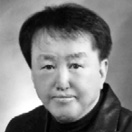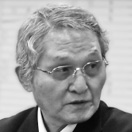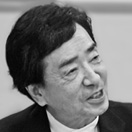Jurors’ Comments
審査講評

Kenji Ekuan (Japan)
- Industrial Designer
After looking at the works at the Final Assessment for the Ishikawa International Urushi Exhibition 2014, I have to say that the world of Urushi has come close to the turning point.
The world of Urushi developed during the period between the stable era of the Tokugawa period in the 17th century and the Sino-Japanese War of 1894-5 of the Meiji period. After the Sino-Japanese War, Japan became militaristic and the societal trend of Japan changed drastically. At the end of the Tokugawa period, the world expositions for crafts were held in various countries. At each exposition, Urushi ware was exhibited and the works held a good reputation from the rest of the world. The minuteness of Urushi ware was unsurpassable. The hothouse that has produced a number of excellent art works is Urushi.
Later, when the Second World War was over, traditional arts and crafts were under the US military occupation and the use of them was banned.
Urushi culture, however, survived. The art form has long been handed down through the use of it in Japanese peoples’ lifestyle. Their way of living has also been handed down in the same way as that of the Tokugawa and Meiji periods. Thus, Urushi culture has lasted until today.
Today, we serve miso soup in an Urushi bowl and we take the design for granted. Urushi ware has long been used at home and people have admired Urushi ware for ages.
Unfortunately, Japanese people’s eating habits have changed recently. Urushi ware does not go with the hamburger. Even today Urushi ware is still used at elaborate inns and Japanese restaurants. This is not enough for a strong cultural foundation.
This time, the works submitted for the competition seem to explore the future of Urushi. No work is similar to each other which are gorgeous and precise. Looking at the works exploring the future, I could not avoid concluding that such a big change of the era has a great meaning. It is important from the perspective of cultural transfiguration. It is not that people lose interest in Urushi, but that they are looking for a new trend of Urushi.
Especially, the Grand Prize winner “Incense Container Rhino” is a curiosity and it gives aesthetic appeal to our everyday lives although it does not look like Urushi ware. A very interesting and stimulating era for Urushi ware has come.

Nagatoshi Ohnishi (Japan)
- Urushi Artist,
- Professor Emeritus at Tokyo National University
of Fine Arts and Music
During the last half century, the aspects of design and function in art have displayed a tendency of craftsmanship that leaves creativity up to an illusion of what the artistic piece hinted to at one point in history, rather than a replica of the expression of the artwork itself.
This tendency can be seen in time honored craftsmanship that, at its inception, had a foundation in artistic expression and traditional construction methodologies. This transformation of design can be seen not only in Japan but also around the world. An illustration of this evolution can be seen in common household items that have been transformed by industrialization. Once founded in style, craftsmanship, and design, now give way to a modern and revolutionized ideal of its original form. Another example of the evolution of art can be seen in modern day technology. Today, the world is instantly and irreversibly connected. All we can do is gaze steadily the merits and demerits of this tendency. However, the fortunate ones remember what we have left behind in terms of the original craftsmanship of design and function, which echoes back to the seminal mission of arts and crafts.
Well, it has been almost 30 years since the Ishikawa International Urushi Exhibition started. This exhibition has explored the treasured charm of Urushi from various perspectives beyond races and boarders. Each year it has been expanded in many ways. This year we received first time applications from Brazil, the Netherlands and Russia. Their sensitivity to this art form has fresh charm that we cannot find in Japanese expressions. I hope these pieces are stimulating for you, I am sure.
I would like to invite your attention to their works.
What is common among European artists including Denmark, France and Germany is that they give this art form a fresh look while honoring their materials in the true spirit of Urushi. I am afraid that Japanese Urushi artists tend to focus all their attention on completing their works perfectly. As a result, they fail to hear the natural voice of Urushi. Do they boast only their techniques? Do they forget to listen and be receptive to the art form of Urushi? I wonder.
The design and function aspect comes out of the dialogue between the artists and Urushi.
The Grand Prize winning work was fashioned after the artist was in constant dialogue with the spirit of Urushi many times. It is my hope that the conversation among the visitors will become lively.

Ryoichi Komatsu (Japan)
- Professor Emeritus at the Kanazawa College of Art
At the Final Assessment, we selected award winners out of 71 works that represented 11 different nations and regions by mutual agreement according to the assessment standard.
Assessment Standard
• with novel lifestyle proposal and usage development
• with novel sensitivity expressions and proposal
• making the best use of the techniques of the artists’ regions or nations
The Grand Prize goes to “Incense Container Rhino” by Takashi Wakamiya of Hikojumakie. This Grand Prize winner has debuted a rather small art piece. It expresses an image of a wild rhinoceros while perfectly balancing sophisticated artwork due to his techniques to handle Urushi gently and delicately.
The highlight of this work is how the head can be twisted and a tiny offertory box will come out from the inside.
Although the offertory box has some drawbacks to the size and construction, the work itself represents a rich creativity and it pursues a possibility of harmony between Urushi tradition and novelty.
I selected “Time Capsule of Life” by Sunhwa Kim from the US as a Ryoichi Komatsu Prize winner. I felt the movement and glorification of life from the dynamic design and the flowery pattern of mother-of-pearl inlay work on the stool. The tradition and design in the novel formation is immediately apparent.

Kwon Sang-Oh (Korea)
- Urushi Artist,
- Professor Dept. of Crafts College of
Arts Silla University, - Director of Lacquer Craft Research Center
Silla University
I would like to congratulate the opening of the Ishikawa International Urushi Exhibition 2014.
This time the exhibition received 50 more applications than last time. We assessed the applied works by dividing the Design Category and the Art Category. The works applied in the Design Category are obviously more moving. The power has come from mingling of ideas between the people in industrial fields and the artisans who have promoted the local industries in Ishikawa for ages.
The works, to me, are conspicuous. They which emerged from traditional forms and techniques and many traditional arts and crafts with technology.
Contemporary arts and crafts should pursue contemporary beauty to blend in with the changes of time by introducing modern techniques and chemical paints and functions.
The Grand Prize winner represents the essence of Urushi arts and crafts in the Art Category. This excellent work makes a profound impact on the viewer due to its beautiful form, minuteness and tension.
The 10 th Exhibition Special Memorial Prize goes to “Sound Booster” in the Design Category. The beauty of form created by a designer harmonizes with an artisan’s techniques. Its role as an example of industrial arts and crafts clearly stands out.
I hope this exhibition proves instrumental in revitalizing local industries and encouraging international exchange through Urushi ware. I also hope the value and beauty of Urushi will be admired in everyday lives.

Fumio Mae (Japan)
- Urushi Artist,
- Living Important Intangible Cultural Asset
- (in the Chinkin carving technique)
Expansion of the design and function aspect of Urushi ware
Arts and crafts have existed since the beginning of time. Throughout the ages, artisans have devoted themselves fastidiously to the art of designing and crafting objects from mixed materials.
The difference between the artists who design industrial arts and crafts and artists that design works that veer from the tradition and more towards impulse can be traced back to the form and function of the object being crafted. The artists born out of the industrial craftsmanship used materials and techniques that utilized the entirety of the materials and often exchanged flair for function. In juxtaposition, the non-industrial artists’ work can vary significantly because each artist creates their work with their own perceptions of an artistic vision and holds targets which reflect individuality over inherent functionality.
This time, the exhibition received applications in two categories; the Design Category and the Art Category.
The works applied in the Design Category should express lifestyle proposals and usage development; in the Art Category expression of sensitivity and novel proposals. The works also should be created with techniques peculiar to each artist’s area. These three points give an assessment standard. All the jurors assessed the works according to the assessment standard. As a result, 16 excellent works with originality and sensitivity were selected as prize winners.
The Grand Prize winner “Incense Container Rhino” has surprised me with the artist’s high exemplary technique and diversity to change the Urushi material into a beautiful form.
Just viewing Urushi we become aware of movement, design, and function.
As we learn more about Urushi, it is easier to understand the complexity of the artist’s devotion and conversation with this craft.
I hope Urushi ware producing areas will be revitalized by means of the works that only you can create, your definite sensation you grasp, and possibility of your craftsmanship and techniques that machines cannot do.

Shinichi Yamamura (Japan)
- Design Consultant,
- President of Cobo Design Co., Ltd.
The Ishikawa International Urushi Exhibition 2014 celebrated its 10 th year since its inception. To mark this occasion the exhibition was divided into two categories; Art Category and Design Category.
The Art Category is defined as a category for the works focusing on expression and beauty with a focus on individual expression and interpretation. On the other hand, the Design Category as a category for proposals of planned products as well as distributable products focusing on functionality.
This time, each applicant could select the category and enter the exhibition. Thanks to this new trial, 207 works were submitted from 15 nations and regions. This is a much larger number of the applications from previous years. I felt satisfied with the number of submissions.
The factors that were highly evaluated were works that displayed multi-functionality; a design that helps make sound or an interactive piece that was to be assembled. Notable examples are the Grand Prize winner “Incense Container Rhino” and the 10 th Exhibition Special Memorial Prize winner “Sound Booster”.
The former is an incense container with a high precision mechanism, while the latter is a set of Urushi sound boosters to boost the sound of a smart phone without a power source.
Both works were made with superior attention to detail and foresight. The works reached a high degree of perfection with great sensitivity, I am delighted that those excellent works were created in Ishikawa where world renowned Urushi ware has long been created. If those award winners play a role in revitalizing Urushi ware, the purposes of this exhibition can be achieved. At this 10 th exhibition, we received diverse works other than artistic works; decorations for clothes, toys, Buddhist Altars, furniture, tableware, lighting apparatus, and musical instruments, to name a few.
The techniques and materials also varied; wood, paper, glass, pottery porcelain, metal, and fabric.
Diverse techniques are applied to decorate a variety of Urushi works. Thus, the diversity of original Urushi ware is utilized for all of excellent pieces exhibited at the Ishikawa International Urushi Exhibition 2014.

Teruko Mitarai (Japan)
- President of T-pot Co., Ltd.
I have enjoyed my participation as a judge for the Preliminary Assessment for digital images. This year, I found a unique fascination with wooden Urushi ware.
Wooden Urushi ware, with visible growth rings, has drawn public attention. During the Preliminary Assessment, however, I felt a great possibility of growth within the art form: dry lacquer; free forms, free sizes, lightness, durability against the dry climate etc. Dry lacquer ware has not been notable despite its rich charm. I am confident the dry lacquer ware will play a leading role in promoting Urushi ware, including exporting the dry lacquer ware to other countries of the world, in years to come.
One more interesting development is that artists have been interested in adhesiveness of the Urushi sap itself. For example, one of the most popular disciplines among women in Japan is Kintsugi, which is to repair of a ceramic piece with gold-dust lacquer. Even the brand “KINTSUGI” of a ceramic ware shop has emerged overseas. Contemporary charm and a new value come out of Kintsugi repaired work. I am personally fascinated with Yuki Nakamura’s work “Growing & Gluing”. The driftwood-like bases are coated with Urushi sap. The craftsmanship reveals a story that the drifted pieces show with the help of Urushi. It is a charming and poetic story. As an Urushi form, I hope the artists or creators at home and abroad will continue to explore possibilities of Urushi from their everyday lives into extraordinary occasions.

